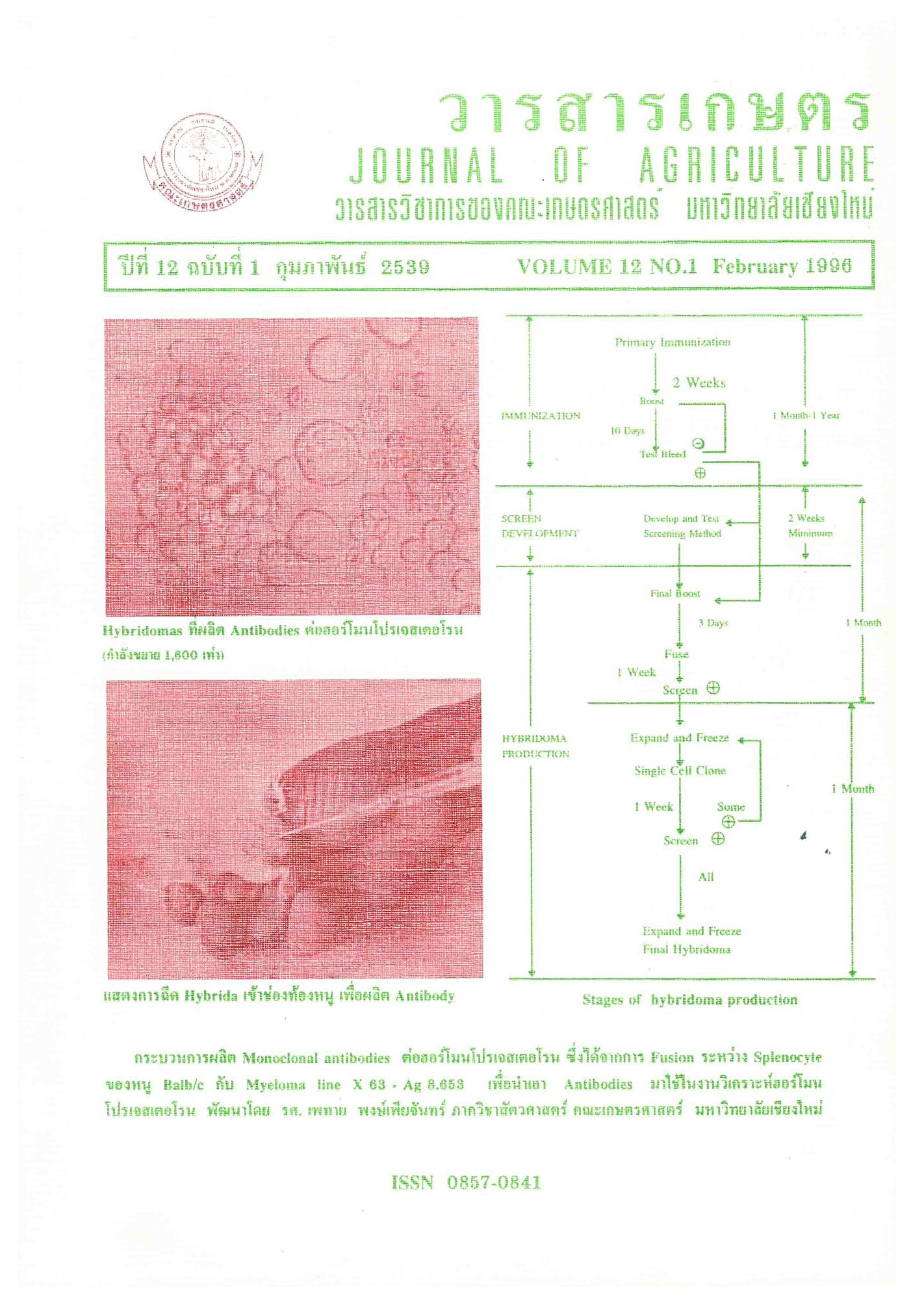ผลของการเลี้ยงโครีดนมลูกผสมขาว-ดำโดยใช้ฟางข้าวปรุงแต่งคุณภาพด้วยยูเรียและกากน้ำตาลเสริมด้วยอาหารก้อนคุณภาพดี
Main Article Content
บทคัดย่อ
การปรุงแต่งคุณภาพฟางข้าวโดยใช้ยูเรียและกากน้ำตาลสามารถเพิ่มโปรตีน และการย่อยได้จากฟางปรุงแต่งตามปกติ ส่วนการทดลองเลี้ยงโครีดนมลูกผสมขาวดำ เพื่อศึกษาการให้ผลผลิตน้ำนมเมื่อเลี้ยงด้วยฟางข้าวลักษณะเส้นปรุงแต่งคุณภาพด้วยยูเรีย 6% แล้วตากแห้ง ฟางข้าวลักษณะเส้นปรุงแต่งคุณภาพด้วยยูเรีย 6% และกากน้ำตาล 5% แล้วตากแห้ง และฟางข้าวลักษณะฟ่อนปรุงแต่งคุณภาพด้วยยูเรีย 6% และกากน้ำตาล 5% ในสภาพสด เสริมด้วยอาหารข้นในปริมาณ 1 กก ต่อน้ำนมที่รีดได้ 2 กก และอาหารก้อนคุณภาพดีซึ่งประกอบด้วย กากน้ำตาล ยูเรีย โปรตีนจากพืช และแร่ธาตุ ได้ผลการทดลองว่าปริมาณน้ำนม (174-17.9 กก FCM/วัน) ปริมาณโปรตีนในน้ำนม (2.90-2.94%) วัตถุแห้งไม่รวมไขมัน (8.6-8.7%) และน้ำตาลในน้ำนม (5.0-5.1%) ในแต่ละกลุ่มแตกต่างกันอย่างไม่มีนัยสำคัญ ปริมาณอาหารหยาบที่กินของโคที่ได้รับฟางปรุงแต่งตากแห้งทั้ง 2 ชนิด (5.8-6.5 กก DM/วัน) แตกต่างกันอย่างไม่มีนัยสำคัญ แต่โคจะกินอาหารหยาบเพิ่มขึ้นอย่างมีนัยสำคัญเมื่อใช้ยูเรีย และกากน้ำตาลปรุงแต่งฟางและให้ในสภาพสด (8.1 กก DM/วัน) ซึ่งมีผลให้ปริมาณไขมันในน้ำนมของโคกลุ่มดังกล่าวเพิ่มขึ้นอย่างมีนัยสำคัญ โคทุกกลุ่มจะเลียกินอาหารก้อนคุณภาพดีใกล้เคียงกันคือเฉลี่ยวันละ 600-700 ก การเพิ่มน้ำหนักของโคทดลองมีแนวโน้มเพิ่มขึ้น เมื่อเลี้ยงด้วยฟางข้าวซึ่งปรุงแต่งคุณภาพโดยใช้ยูเรียและกากน้ำตาล
Article Details
เอกสารอ้างอิง
บุญล้อม ชีวะอิสระกุล และสมคิด พรหมมา. (2536). การใช้หัวอาหารก้อนเสริมฟางหมัก และอาหารข้นในโคนมรุ่น. วารสารวิจัยและส่งเสริมวิชาการเกษตร. 10 (1): 35-45.
AOAC. (1975). Official Methods of Analysis. 12th ed. Association of Official Analytical Chemists. Washington. D.C.
Cochran, W. G. and G. M. Cox. (1957). Experimental Design. 2nd ed., John Wiley, N. Y.
Goering, H. K. and P. J. Van Soest. (1970). Forage Fiber Analysis. USDA-ARS Handbook No. 379.
Miller, WJ. (1979). Dairy Cattle Feeding and Nutri tion. Academic Press, New York.
NRC. (1988). Nutrient Requirements of Dairy Cattle. 6th ed., National Academy Press, Washington, D.C.
Promma, S., S.Tuikampee, N. Vidhayakorn and R.W. Froemert. (1985). The effect of urea-treated rice straw on growth and milk production of crossbred Holstein Friesian dairy cattle. In: The Utilization of Fibrous Agricultural Residues as Animal Feeds. (Ed. P.T.Doyle). IDP, Canberra. pp.88-93.
Promma, S. (1993). Optimization of urea-treated rice straw feeding in crossbred Holstein cattle. Ph.D. Dissertation. Kyushu Tokai University. Kumamoto, Japan.
Promma, S., S. Tuikumpee, P. Jeenklum and T. Indratula. (1993a). Effect of varying dietary levels of total digestible nutrients, protein and fiber on the growth of crossbred Holstein heifers fed urea-treated rice straw diets under two feeding systems. AJAS. 6: 509-514
Promma, S., P. Jeenklum and T. Indratula. (1993b). Production responses of crossbred Holstein
milking cows fed urea-treated rice straw at three different fiber levels. AJAS. 6: 91-97.
Promma, S., I. Tasaki and B. Cheva-Isarakul and T. Indratula. (1994a). Stabilization with sulfuric acid of the crude protein in urea-treated rice straw. AJAS. 7: 481-486.
Promma, S., I.Tasaki and B.Cheva-Isarakul and T. Indratula. (1994b). Effect of feeding ncutral-ized urea-treated rice straw on milk production of crossbred Holstein cows. AJAS. 7: 493-498.
Roughan, P. G. and R. Holland. (1977). Predicting in vivo digestibilities of herbages by exhaustive enzyme hydrolysis of cell well. J.Sci. Food Agr. 28: 1057-1064.
Steel, R. G. D. and J. H. Torrie. (1980). Principles and Procedures of Statistics; A Biometrical Approach. 2nd ed., McGraw-Hill, Co., Inc., New York
Wanapat, M., S. Praserdsuk, S. Chanthai and A. Sivapraphagon. (1982). Effect on rice straw utilization of treatment with ammonia released from urea and/or supplementation with cassava chips. In: The Utilization of Fibrous Agricultural Residues as Animal Feeds. (ed. P. T. Doyle). School of Agriculture and Forestry, University of Melbourne, Parkville. Victoria, Australia. pp. 95-101.
Wanapat, M. and S. Uriyapongson. (1987). A comparison of liveweight performance and carcasses of crossbred dairy cattle fed untreated or urea-treated rice straw with concentrate supplement. In: Ruminant Feeding Systems Utilizing Fibrous Agricaltural Residues. (ed. R. M. Dixon). International Development Program of Australian University and Colleges, Canberra, Australia, pp, 181-186.


